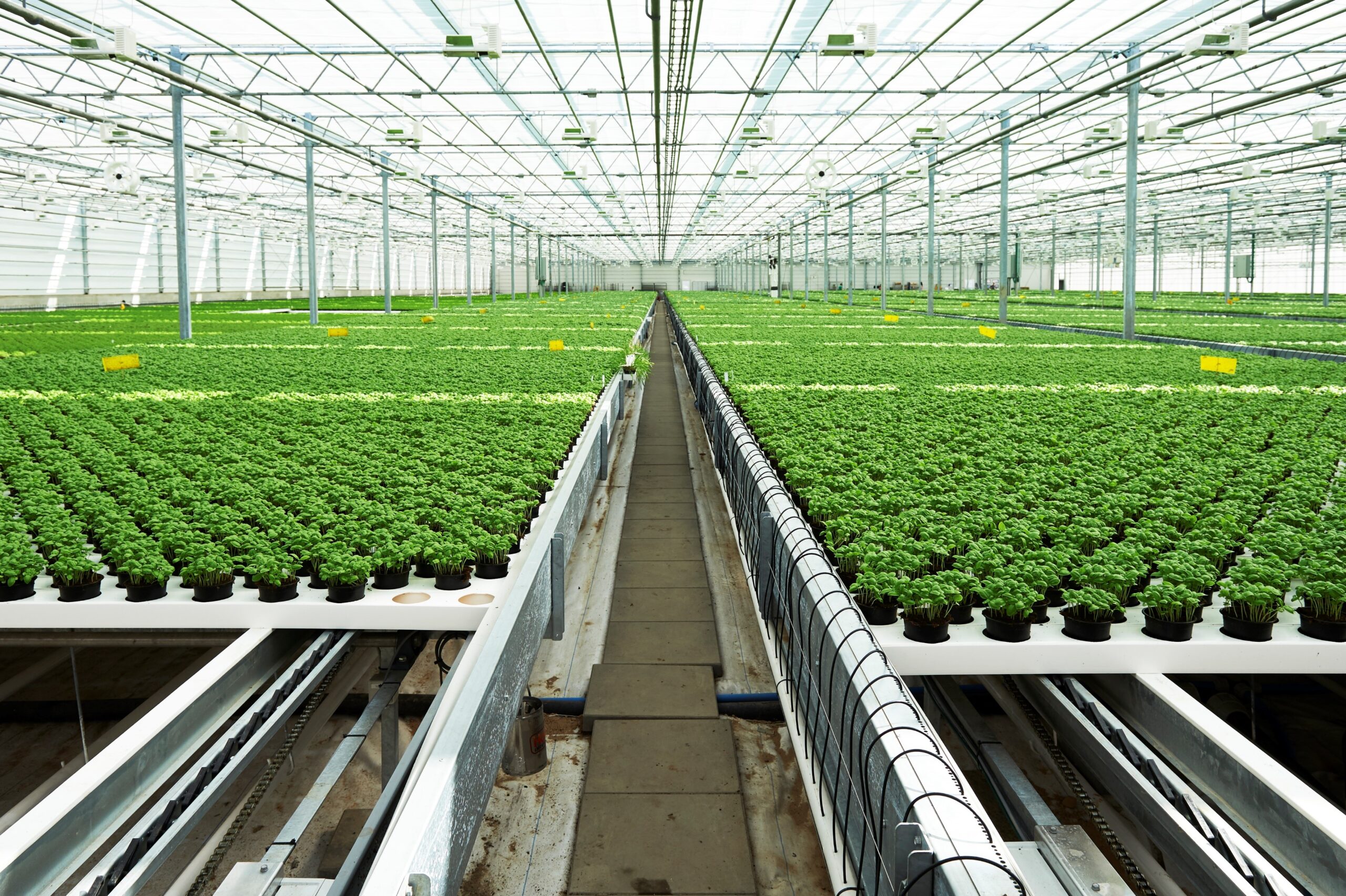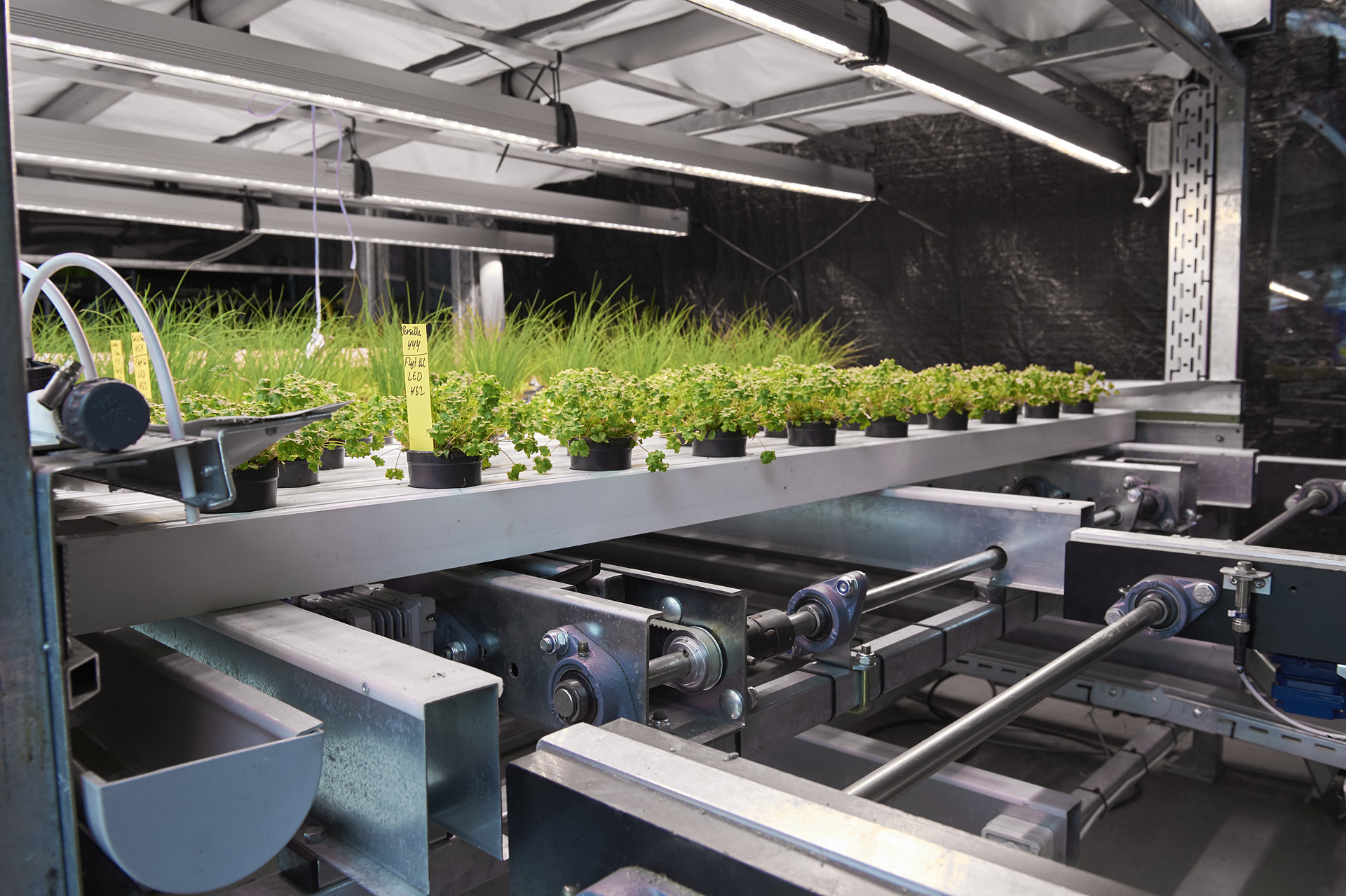Optimizing Agriculture: The Synergy of Horizontal and Vertical Farming
Both Horizontal and Vertical Farming have their places in modern agriculture, and the choice between them depends on factors such as available space, resources, market demand, and efficiency.
At Viemose DGS, we have merged the strengths of Horizontal Farming with Vertical Farming methods. Through the utilization of our innovative Moving Gutter System in a stacked layout, we have significantly optimized traditional indoor farming methods.
In this article, we will explore both methods in depth, examining their respective advantages and disadvantages.
What is Horizontal Farming in the context of Vertical Farming?
Horizontal Farming most commonly refers to the conventional method of agricultural cultivation where crops are grown on flat land, typically in large outdoor fields or plots. This traditional approach involves planting crops across the ground surface, utilizing machinery and equipment for tasks such as planting, irrigation, and harvesting.
In the context of Vertical Farming, Horizontal Farming is frequently described as large indoor greenhouses featuring extensive bench sections that facilitate the automated movement of plants for cultivation. These systems include Moving Gutter Systems, Dynamic Gutter Systems, Mobile Gully Systems, Moving Gully Systems, and Pond Systems such as Deep Water Culture.

Advantages of Horizontal Farming
Horizontal Farming offers several advantages over Vertical Farming. Firstly, it allows for large-scale agricultural production, making it suitable for extensive cultivation of crops. Additionally, Horizontal Farming accommodates a wide variety of crops, including those with deeper root systems or larger spatial requirements.
The even distribution of light across a horizontal area ensures that all plants receive adequate sunlight for efficient photosynthesis, promoting healthy growth and maximizing yield potential.
Moreover, Horizontal Farming is simpler and easier to set up compared to Vertical Farming, as it typically requires less specialized infrastructure and can rely on existing agricultural practices and equipment. This ease of setup can lower barriers to entry for farmers and facilitate the adoption of agricultural practices, especially in regions with limited resources or expertise.
Disadvantages of Horizontal Farming
Nonetheless, Horizontal Farming also has some disadvantages when contrasted with Vertical Farming. It demands a great amount of space, necessitating significant square footage. Additionally, in certain instances, it can prove energy-intensive, as the continuous movement of plants requires a notable amount of energy to sustain.
Moreover, Horizontal Farming may not be suitable for certain crops that require specific growing conditions or cannot thrive in large open areas. This limitation can restrict the diversity of crops that can be cultivated using this method.
What is Vertical Farming?
Vertical Farming has transformed the landscape of plant cultivation through the utilization of vertically stacked layers or structures. This innovative approach leverages cutting-edge technologies such as hydroponics, which enables plant growth without soil, aeroponics, which suspends plants in the air and nourishes their roots with misted nutrients, and artificial lighting to replicate ideal growth conditions for plants.
By adopting these advanced techniques, Vertical Farming establishes controlled environments where variables like light, temperature, and humidity are carefully regulated to optimize plant growth. This precision enables crops to flourish more effectively compared to traditional soil-based farming methods.
Moreover, Vertical Farming optimizes space utilization by vertically stacking crops, effectively expanding the available growing area within a confined footprint. This spatial efficiency is especially advantageous in urban settings where arable land is limited.

Advantages of Vertical Farming
Vertical Farming enables year-round cultivation of crops independent of seasonal changes and weather conditions. Controlled indoor environments allow for consistent growing conditions, leading to continuous production and reduced dependence on external factors.
By minimizing land use, water consumption, and pesticide use, Vertical Farming reduces its environmental footprint compared to conventional farming methods. This makes it a more efficient option for food production, with lower emissions and pollution levels.
Moreover, Vertical farms can be located closer to urban centers, reducing transportation distances and carbon emissions associated with food distribution. This promotes the concept of locally grown produce, providing fresh and nutritious food to urban populations.
Disadvantages of Vertical Farming
Vertical Farming, despite its numerous advantages, also faces several challenges and disadvantages.
Firstly, the initial setup costs for Vertical Farming can be immense. The infrastructure required for Vertical Farming, including indoor growing facilities, lighting systems, irrigation systems, and automation technology, often involves significant upfront investments. These costs may pose barriers to entry for small-scale farmers or entrepreneurs looking to establish Vertical Farming operations.
Moreover, Vertical Farming systems are complex and require specialized knowledge and expertise to design, implement, and maintain effectively. Managing factors such as lighting, temperature, humidity, nutrient levels, and pest control in controlled indoor environments can be challenging and may require skilled personnel.
Synergizing Horizontal and Vertical Farming Methods for Maximum Output
At Viemose DGS, we merge the benefits of Horizontal Farming with Vertical Farming technologies. By creatively implementing the Moving Gutter System within a stacked layer and integrating various Vertical Farming technologies, we aim to enhance yields, production, and overall efficiency.
We utilize state-of-the-art climate control systems to uphold optimal temperature, humidity, and airflow, creating ideal growing environments. Our lighting solutions, which include LED grow lights, offer tailored spectra to support plant growth at every developmental stage.
Enhancing Efficiency with the Nutrient Film Technique
Adopting soilless cultivation techniques like the Nutrient Film Technique ensures precise nutrient delivery, promoting plant health and productivity. Additionally, our systems incorporate environmental monitoring and control systems to continuously assess variables such as CO2 levels and nutrient concentrations, allowing for immediate adjustments if necessary.
Critically, our systems are fully automated, enabling predictive modeling and adaptive control strategies that continuously enhance productivity.
By seamlessly integrating Vertical Farming technologies into Horizontal Farming practices, we ensure compatibility across diverse systems, striving to optimize operations and fully capitalize on the advantages of indoor farming.
FAQS on Horizontal Farming Vs. Vertical Farming
How does Viemose DGS address the challenges and disadvantages associated with Vertical Farming, such as high initial setup costs and complex maintenance requirements, to maximize efficiency and productivity in their operations?
We address the challenges associated with Vertical Farming through innovative solutions and advanced technologies. We utilize state-of-the-art climate control systems to maintain optimal growing conditions, utilize LED lighting solutions for tailored spectra to support plant growth, and adopt soilless cultivation techniques like the Nutrient Film Technique for precise nutrient delivery.
Additionally, our systems incorporate environmental monitoring and control systems for real-time adjustments, and we fully employ automated processes for predictive modeling and continuous productivity enhancement. By seamlessly integrating Vertical Farming technologies into our operations, we strive to optimize efficiency and fully leverage the advantages of indoor farming.





